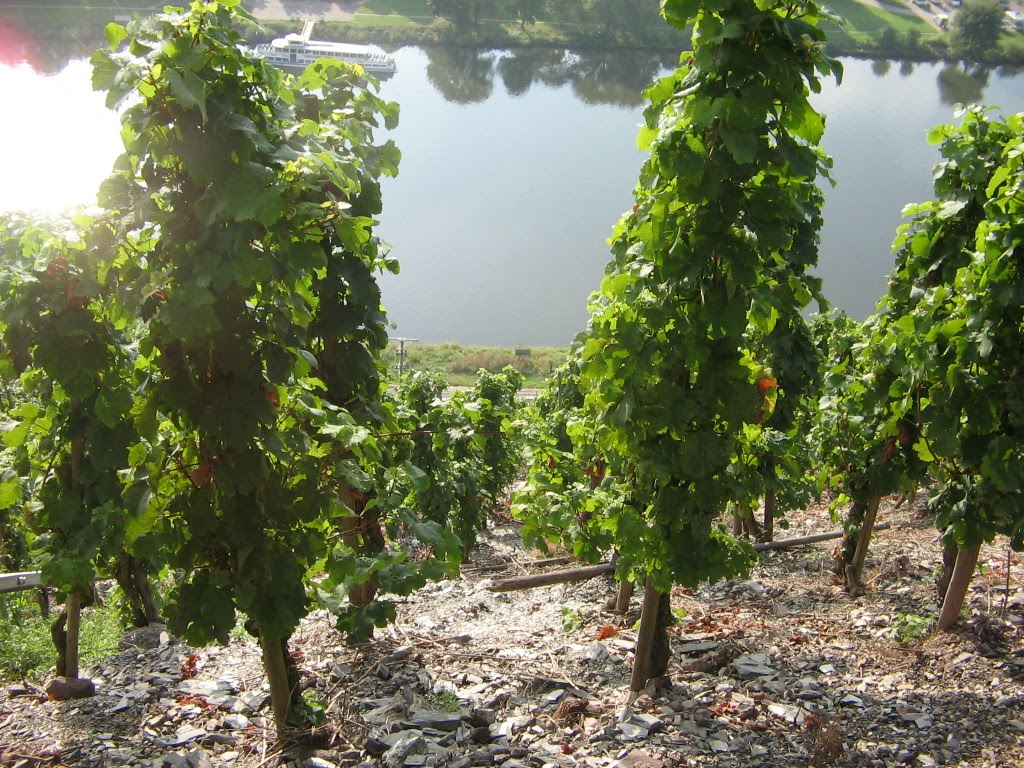n
a. You’re not happy. If that’s the case you really have serious issues. Counseling and/or medication are strongly advised.
b. You are deliriously happy; as it should be, and the following thoughts might enter your brain pan in rapid succession:
“Life is good.”
“This must be what the angels drink in heaven.”
“I feel like I’m in a Muppets Movie.”
“I think I can actually dance.”
“Where can I get more of this?”
I’m not sure why, but Riesling does this, especially German Riesling. In fact, wine professionals tend to get more compulsive about German Riesling than just any other wine. Half my cellar, which is not huge by any stretch, is German Riesling. That’s not a rare thing. It’s not uncommon among my fellow MS’ to own dozens of cases of German Riesling–even 100-plus cases in a few instances. Why do we get so dangerously excited about a wine that is white, light, and usually slightly sweet? There are several reasons:
Drinkability: as jaded as one can become after many years in the business, it’s easy to forget that wine is supposed to be delicious. Riesling reminds us with each sip that the same wine can be remarkably complex and yet utterly delicious.
Complexity: Riesling, in particular German Riesling, has a wider expression of aromas and flavors than any other white wine. And because the wine is made in so many different styles–from rich, dry, and complex Grosse Lage bottlings to cranium-rattling sweet TBA’s and everything in between—you’ll bound to find just about any and everything in the glass. In Master Sommelier classes we often teach that white wines have five different fruit groups. I’m convinced that Riesling has eleven (or is that infinity?).
Terroir: with German Riesling, there’s no winemaking cosmetic surgery. What you get it is what was harvested, fermented, and bottled–and nothing else. That means the wines have unmatched transparency and display the unique terroir of the vineyard as well as or better than any other wine. What more could a wine geek possibly want? I’m not sure, but that’s why we tend to get worked up about German Riesling like a bunch of Chihuahuas on crank.
Ageability: the oldest unfortified white wine I’ve ever tasted was an 80-year-old Spätlese Riesling from the Piesporter Goldtröpchen vineyard from Rheinhold Haart in the Mosel. The estate had three remaining bottles of that vintage in the cellar and owner/winemaker Theo Haart opened one of them for his grandfather’s 80th birthday the day before our visit. He then filled a half bottle with some of the wine for our tasting the next day. When opened for us the wine was bright, youthful, and more than just alive–it was simply amazing. Why does Riesling age so well? It must be the magic combination of low alcohol, high acid, and the touch of residual sugar. It’s not uncommon for Spätlese and Auslese wines from top producers/vineyards/vintages to age for several decades–if you have the patience, that is.
Food flexibility: while that mammoth HGH-laced Cabernet may be just the thing for your chipotle-encrusted half-steer, the same wine will be sent crashing to terra firma like a damaged UFO when faced with the likes of a composed salad of micro-greens and a mango foam vinaigrette. Ah vinaigrette, the wine slayer. Nothing eviscerates a tannic red like the high acidity of vinegar. The answer? A high acid white with just a touch of sweetness. Riesling, if you please.
Still hesitant to jump on the Riesling band wagon along with the rest of us? Let me offer one further bit of sage advice.
It’s OK to drink slightly sweet wine
There, I said it. Remember the part of the Mel Brook’s movie “History of the World, Part I?” The part where Moses (aka Mel Brooks) comes down from the mountain with 15—not 10—commandments and drops one of the tablets breaking it to bits? I’m convinced that one of those long lost five commandments on that broken tablet said that it’s OK to drink slightly sweet wine. That means, dear reader, the same style of wine you began your vinous career with back in the day is not only still good, but might actually be timely and even heroic. Who knew?
Suggested Wines
Here are some of my favorite German Rieslings. If the language scares you, don’t freak out. Remember, there’s no crying in baseball so there’s no freaking out in wine. The names of German Rieslings all have two words just like any wine from Burgundy.The first is the name of the village and the second the name of the vineyard. My suggestion is to look for Kabinett (off-dry) or Spätlese (slightly sweet) wines from the producers and vineyards listed below. In terms of purchase, simply plug any of these names into winesearcher.com along with a recent vintage and you’ll be more than half way home. Prost!
Mosel:
1. Mönchhof:
Ürziger Würzgarten, Erdener Prälat
2. Dr. F. Weins-Prüm:
Wehlener Sonnenuhr, Ürziger Würzgarten, Graacher Himmelreich
3. J.J. Prüm:
Wehlener Sonnenuhr, Graacher Himmelreich
4. Selbach-Oster:
Wehlener Sonnenuhr, Zeltinger Sonnenuhr, Graacher Domprobst
5. Wegler:
Bernkasteler Doctor
6. Fritz Haag:
Brauneberger Juffer Sonnenuhr
7. Rheinhold Haart:
Piesporter Goldtröpchen
8. Egon Müller:
Scharzhofberger
9. Zilliken:
Saarburger Rausch
10. von Kesselstadt:
Josephshöfer, Bernkasteler Doctor, Scharzhofberger
Rheingau:
1. Franz Künstler:
Hochheimer Kirchenstück, Hochheimer Hölle, Hochheimer Stielweg
2. Robert Weil:
Kiedricher Gräfenberg
Rheinhessen:
1. Gunderloch:
Nackenheimer Rothenberg
Nahe:
1. Dönnhoff:
Niederhäuser Hermannshöhle, Oberhäuser Brücke, Schlossböckelheimer Kupfergrube
2. Emrich-Schönleber:
Mönziger Hallenberg, Mönziger Frühlingsplätzchen
Pfalz:
1. von Buhl:
Forster Kirchenstück, Forster Ungeheurer
2. Müller-Catoir:
Haardter Bürgergarten, Gimmeldinger Mandelgarten
nn
